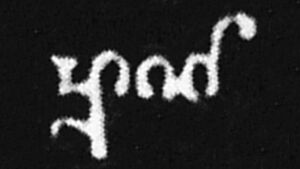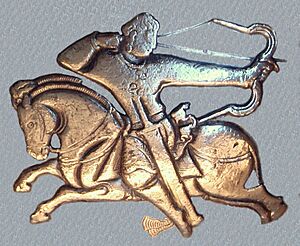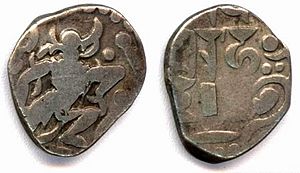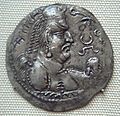Huna people facts for kids
Quick facts for kids Hunas |
|
|---|---|
| Region | Uttar Pradesh, Punjab, Rajasthan, Gujarat, Himachal Pradesh, Haryana, Jammu and Kashmir, Bihar, Sindh, Gilgit-Baltistan, Nuristan, Khyber Pakhtunkhwa, Balochistan, Maharashtra, Delhi |
The Hunas or Huna (Middle Brahmi script: ![]()
![]() Hūṇā) was a name given by people in ancient India to groups of tribes from Central Asia. These tribes entered the Indian subcontinent through the Khyber Pass around the late 400s or early 500s CE.
Hūṇā) was a name given by people in ancient India to groups of tribes from Central Asia. These tribes entered the Indian subcontinent through the Khyber Pass around the late 400s or early 500s CE.
The Hunas took control of areas as far south as Eran and Kausambi. Their invasions greatly weakened the powerful Gupta Empire. However, the Hunas were eventually defeated by a group of Indian kings. This group included King Yasodharman and the Gupta emperor, Narasimhagupta. They defeated a Huna army and its ruler Mihirakula in 528 CE, driving them out of India.
The Hunas are thought to have included several groups like the Xionites, Hephthalites, Kidarites, Alchon Huns, and Nezak Huns. Sometimes, these names were used to describe the Hunas in general. While these groups were part of the Hunas, the names were not always exactly the same. Some historians believe the Hunas were Ephthalite Huns from Central Asia. It is also unclear if the Hunas were related to the Huns who invaded Europe around the same time.
At their largest, the Hunas controlled regions in India up to Malwa in central India. Their repeated attacks and the wars they caused were a major reason for the decline of the Gupta Empire.
Contents
History of the Hunas
Chinese records connect the Central Asian tribes of the Hunas to the Xiongnu from northeast Asia. They also link them to the Huns who later invaded Europe. Some experts, like Gerald Larson, suggest the Hunas were a mix of Turkic and Mongolian groups from Central Asia.
Early European writings, such as those by Ptolemy in the 2nd century, mention the Huns. Later texts by Marcellinus and Priscus also describe the Huns as people from inner Asia.
White Huns and Their Lifestyle
A Roman historian named Procopius of Caesarea, writing in the 6th century, talked about the Huns of Europe. He also mentioned the Hephthalites, who were called "White Huns." These White Huns conquered the Sassanids and invaded northwestern India.
Procopius said that the Hephthalites were related to the Huns "in fact as well as in name." However, he noted some differences. The Hephthalites were settled, meaning they lived in one place, unlike other Huns who moved around. They also had white skin and "not ugly" features.
Procopius described them:
The Ephthalitae Huns, who are called White Huns [...] The Ephthalitae are of the stock of the Huns in fact as well as in name, however they do not mingle with any of the Huns known to us, for they occupy a land neither adjoining nor even very near to them; but their territory lies immediately to the north of Persia [...] They are not nomads like the other Hunnic peoples, but for a long period have been established in a goodly land... They are the only ones among the Huns who have white bodies and countenances which are not ugly. It is also true that their manner of living is unlike that of their kinsmen, nor do they live a savage life as they do; but they are ruled by one king, and since they possess a lawful constitution, they observe right and justice in their dealings both with one another and with their neighbours, in no degree less than the Romans and the Persians
Huna Invasions of India
The Kidarites are generally seen as the first group of Hunas to enter India. They invaded Bactria in the late 300s CE.
The Gupta Empire, led by Skandagupta in the 400s CE, successfully fought off one Huna attack in 460 CE. But over the next few years, the Hunas, led by different kings, managed to push further into the Indian subcontinent.
The Hunas first set up their base in the Oxus basin in Central Asia. By about 465 CE, they controlled Gandhara, a region in northwestern India. From there, they spread into various parts of northern, western, and central India. The Hūṇas are mentioned in several old Indian texts. These include the Rāmāyaṇa, Mahābhārata, Purāṇas, and Kalidasa’s Raghuvaṃśa.
In 528 CE, a group of Indian kings launched another campaign. They finally defeated King Mihirakula and his Huna army. This victory was carved onto a stone pillar in Mandasaur, Central India. The pillar honored King Yashodharman, one of the leaders of the Indian kings. The Huna kings are described as "rude and cruel" in this inscription. They were also known for destroying Buddhist monasteries and learning centers in northwestern India.
A historian named Sumpa Yeshe Peljor, writing in the 1700s, listed the Hunas with other ancient Central Asian peoples. These included the Yavanas (Greeks), Kambojas, Tukharas, Khasas, and Daradas.
Hunas and Later Indian Groups
The Gurjara-Pratiharas suddenly became a strong power in northern India around the 6th century CE. This happened shortly after the Hunas invaded that region. The Gurjara-Pratihara group was "likely" formed when the Alchon Huns (White Huns) mixed with local Indian people.
It is possible that the Gurjara-Pratihara kingdom was a Hunnic state, but its exact beginnings are not fully clear. In a text called Harshacharita from the 7th century CE, the Gurjaras are linked to the Hunas. Some of the Hunas may also have helped form the Rajputs, who were known as fierce warriors.
Huna Religious Beliefs
The exact religious beliefs of the Hunas are not fully known. It is thought that their beliefs were a mix of different practices. These included worshipping their ancestors, totemism (believing in a spiritual connection with animals or plants), and animism (believing that spirits live in natural objects).
Two monks, Songyun and Huisheng, visited the leader of the Hephthalite nomads. They met him at his summer home in Badakshan and later in Gandhara. They noticed that the Hephthalites did not follow Buddhist law. Instead, they worshipped many different gods.
Images for kids
-
The "Hephthalite bowl", NFP Pakistan, 5th or 6th century CE. British Museum.
See also
- Kushan Empire
- Gurjaras
- Gurjara Pratihara dynasty
- 36 royal races
- Ancient India and Central Asia
- Alchon Huns









